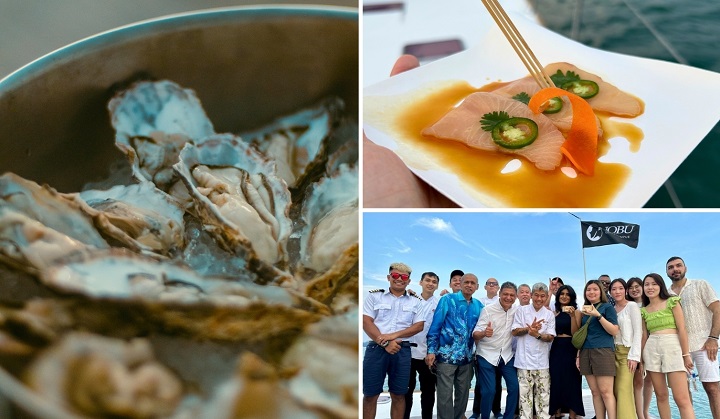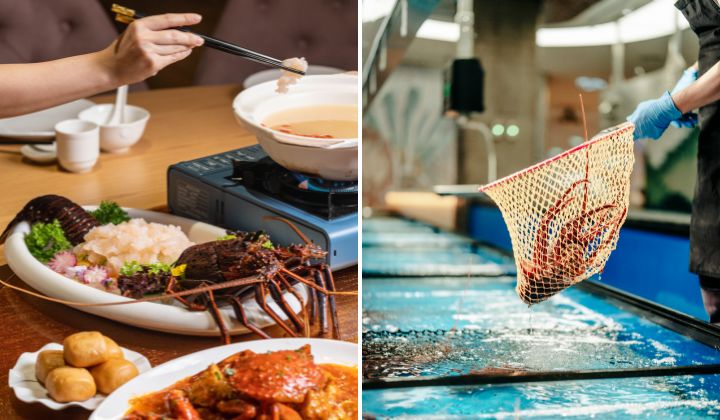Zen By Mel’s Volume: Jordan Menu Brings The Best Of Japanese & Southeast Asian Flavours [Review]
Crafted by Chef Jordan, the new menu features recipes from heritage dishes, favourite flavours, and a symbolic memory of his journey in the culinary industry.

Subscribe to our FREE Newsletter, or Telegram and WhatsApp channels for the latest stories and updates.
Zen By Mel introduces its new menu Volume: Jordan, which will serve as the staple selection alongside its seasonal offerings.
Volume: Jordan is crafted by Chef Jordan Alexis and features a delightful blend of Japanese and Southeast Asian flavours.
The recipes are a symbolic collection of Chef Jordan’s favourite flavours and memories from his start of his culinary journey until now. He was originally a hospitality student before deciding to change tracks and jump right into the kitchens of the culinary world.
He shared that these recipes got him through hard times and reminds him to continue to do better for himself.
Some items on the menu are also inspired by heritage dishes based on his mother’s recipe. Although he said it might be cliché to use his mother’s recipe, he has no qualms about doing so because these recipes made him who he is today.
The menu has a focus on woodfire smoking and charcoal cooking and combines them to bring out both Japanese and Southeast Asian flavours.
Volume: Jordan features an a la carte lunch selection and Zen By Mel’s renowned 11-course and 8-course dinners.
We tried their 11-course dining experience to taste firsthand what it’s all about.
Volume: Jordan 11-course menu
Appetisers
- Akaebi
- Wagyu/Scallop Tartare
- Potage
- Maguro
- Sweet Corn Soup
Mains
- Smoked Chicken
- Choice of Halibut, Steak Cut, Hokkaido Scallops, or Iberico Lamb
- Quack-nabe
Desserts
- Ume Sorbetto
- Imperial Matcha 2.0
- Forest Gump
The Taste Test
For appetisers, we were served focaccia bread with rosemary, cherry tomatoes, and Kalamata olive. It’s served with dipping sauce made of truffle oil mixed with a bit of smoked Japanese mushroom vinegar.
Dipping the warm and crisp bread into the dipping sauce brings out a lovely mushroom flavour and a hint of sweetness from the cherry tomato.

This dish was followed by three more dishes: Akaebi, Wagyu & Scallop Tartare, and Potage. Starting with Akaebi, it’s two panni puri shells filled with delicious headroe paste flavoured with mango kerabu and kizami pepper and topped with ebiko for a slight crunch. For the best taste, drop two to three drops of kaffir lime oil onto the shells before eating it all.

The second course is the Wagyu & Scallop Tartare. Both tartares are topped with Iranian caviar to give them a slightly salty flavour and the green pearls are made from Thai basil for an elevated profile. The Hokkaido scallop had a nicer texture and milder flavours than the soft wagyu. Despite this, they are both delicious and flavourful in their own ways.
The Potage is presented as two cute cubes of potato mille-feuille topped with chilli glaze, kelulut honey, and sesame seeds for crunch. The Sabahan kelulut honey’s mild sourish taste provides a nice flavour balance with the sweetness of the potato and the spice kick from the chilli glaze on top of the aromatic sesame flavour.
After tasting many flavours, we were given a mini bottle of Bentong ginger and Sudachi lime drink as a palate cleanser and prepare for the next course. The drink was also glittery!

This is followed by Maguro, basically smoked Bluefin tuna flavoured with Hainanese chilli crème and wrapped in nori (seaweed). The green sauce on the roll is the Peruvian aji verde for a hint of spice instead of the usual wasabi.
For someone who doesn’t usually prefer having tuna sashimi, this Maguro is flavourful. It has a mix of saltiness with a sweet hint near the end and a refreshing tang. The improved Hainanese “chicken rice sauce” and the aji verde paired well to round up the flavours together.
The Maguro is served alongside the Nigiri sushi which featured the same tuna with a smokier flavour as it went through applewood smoking.
Up next, the Sweet Corn Soup is made by steeping corn, baby corn, leek, burnt onion, goji berries, and Beijing dried scallops for over eight hours to bring out the natural sweetness. The goji berries would be discarded before steeping a new batch to preserve its sweetness.
The soup may seem ordinary when compared to the previous dishes but it was a hearty drink. Having the soup is like another pit stop to savour the current flavours before moving on to another.

After slurping the soup, we had the first main of the night. The Smoked Chicken is kampung chicken flavoured and smoked in cedarwood and applewood with a bit of malt and beer for a slight bitterness. The chicken sits on a bed of roasted cauliflower puree and garlic oil with a side of Binchotan kalian dusted with seaweed dust.
For the second main, we had the Halibut fish cooked on charcoal and brined with lemon solution. The sauce is made of a blend of asam pedas paste, egg yolk, and French white wine. The fish dish is served with a side of somtam papaya salad and grilled ladies’ fingers. The addition of peanuts and bunga kantan oil elevates the dish’s flavour profile.
The soft and flaky fatty fish tasted sweet and sour with a slight spice kick, reminiscent of Thai food flavours.

Last but not least, the rice dish that every Asian looks for, the Quack-nabe. By this point, I was already feeling full but still managed to enjoy bites of this fragrant dish.
Basically, it’s an Ipoh duck claypot rice marinated with spices. The duck bones were used to make the broth with shallot oil. The rice dish is topped with negitama, handmade furikake, sesame seeds, bonito flakes, and fried shallots.
The kitchen staff mixed the rice dish for us before serving in individual bowls. The duck meat is smooth and easy to chew and I loved the crunchy bits in the rice. The mixed ingredients provide a burst of flavours, making the Quack-nabe easily one of the best-tasting fried rice I’ve tried.

Finally, it was time for desserts. The first is Ume Sorbetto, a sweet and sour cool palate cleanser in the form of a sorbet made of ume, raisin, honey-roasted almonds, and raspberry.
The second sweet dessert is the Imperial Matcha 2.0 featuring ceremony-grade matcha. It’s a matcha mousse tartlet with raspberry puree inside. The side is a gelato made of Hokkaido milk with Madagascar vanilla. The sour hint from the raspberry balances out the sweetness of the matcha while the gelato provides another layer of mild sweetness.
The desserts in Forest Gump were arranged to look like a fairy ring because they’re shaped like mushrooms. The “mushroom” is made from Belgian dark chocolate while the “stump” with three dots on it is made of Malaysian passion fruit and white chocolate mousse. The pink “stump” is made of sirap bandung mousse with a little bit of lychee.
The passion fruit one has a dense texture with sweet flavours while the sirap bandung one has a strong fragrance of the syrup but not overly sweet. The chocolate mushroom has a slightly bitter taste and the wafer bottom provides a nice crunch.
The Verdict
Volume: Jordan offers a filling and flavourful meal. Some of my favourite dishes include the Halibut, the Quack-nabe, the desserts, and appetisers.
Compared to the other dishes on the menu, the flavours of the Smoked Chicken felt subdued. For a fine dining setting, it might be preferable to have boneless meat.
Overall, the experience was satisfying and we look forward to seeing what else Zen By Mel and Chef Jordan have to offer.
Volume: Jordan menus
Lunch: A la carte menu starts from RM118 per pax
Dinner: The 8-course menu starts from RM288 per pax, the 11-course menu starts from RM388 per pax.
Zen by Mel
Address: F-10-01, Pusat Perdagangan Bandar, Persiaran Jalil 1, Bukit Jalil, 57000 Kuala Lumpur, Wilayah Persekutuan Kuala Lumpur (next to Tokyo 9 Bar, across Chagee).
Operation Hours:
Monday to Sunday, Closed on Tuesdays
Lunch:
First Session: 12.00pm to 1.30pm
Second Session: 2.00pm to 3.30pm
Dinner:
First Session: 6.00pm to 8.00pm
Second Session: 8.30pm to 10.30pm
Instagram: Zen By Mel
For reservations: https://letsumai.com/widget/zen-by-mel
Share your thoughts with us via TRP’s Facebook, Twitter, Instagram, or Threads.





